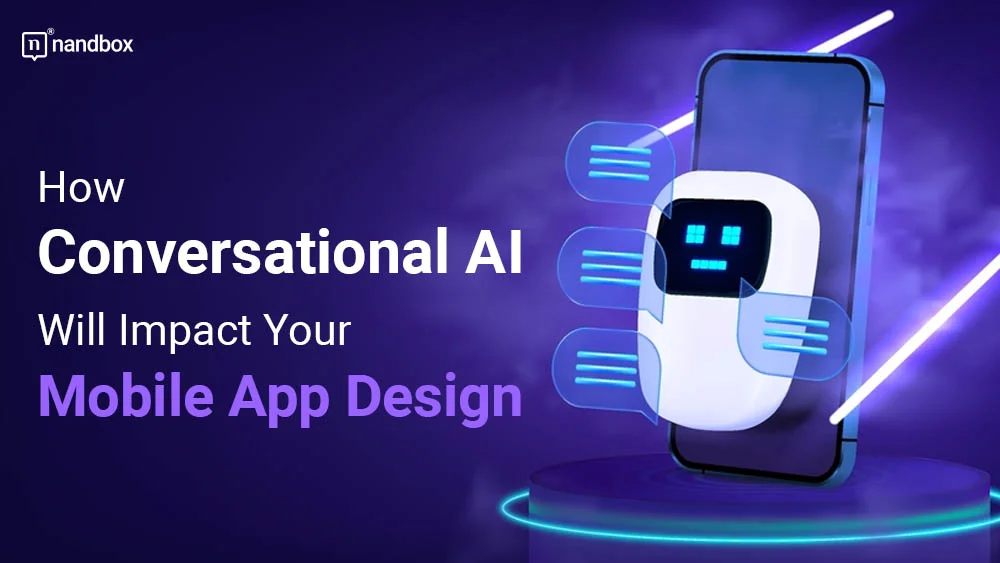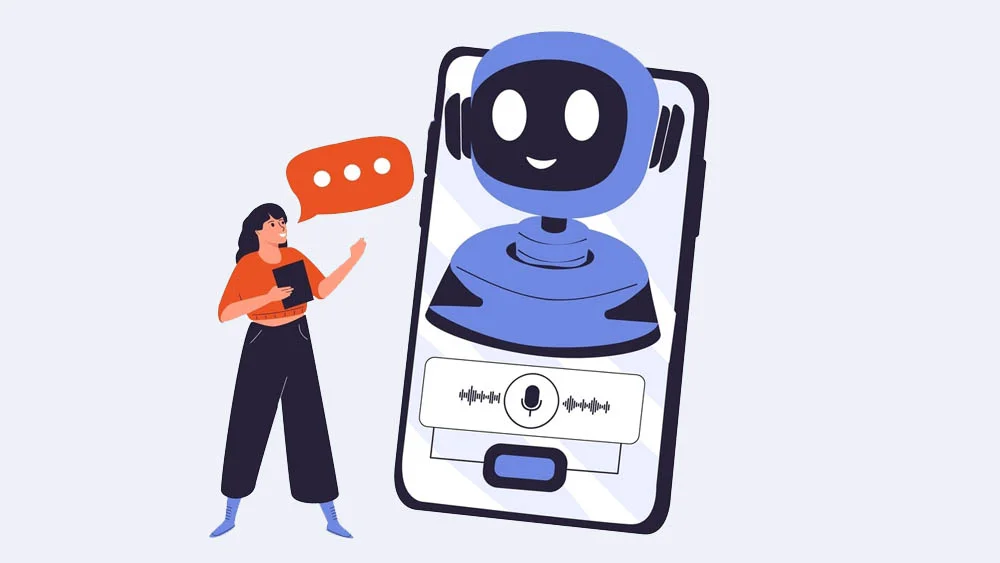How Conversational AI Will Impact Your Mobile App Design
Conversational artificial intelligence (AI) is a technology that redefines the way people interact with their digital devices. At its core, conversational AI is software designed to simulate human dialogue. It is in the voice assistant that wakes the user in the mornings, the chatbot that helps with online shopping, and soon, it may just be in every mobile app.
This technology has seen tremendous growth, largely due to its power to transform user experiences. Essentially, it adds a layer of simplicity and personalization that reshapes people’s perception of what a mobile app can do.
Take a deep dive into the world of conversational AI and understand its impact on mobile app design. That way, you can understand why it is crucial and how you, too, will be able to enhance the user experience by integrating this technology into your mobile app design.
Conversational AI Explained
Conversational AI is about creating software that converses like humans. It works by processing and understanding natural language, converting it into structured data, and generating an appropriate response. You can find this technology embedded in various forms like chatbots, voice assistants, and AI-powered messaging apps.
Chatbots are often on websites and apps, helping users with queries and tasks. For example, Apple’s Siri is a voice assistant integrated into Apple devices where users can interact with Siri using natural language to perform various tasks. These may include setting alarms, making phone calls, or searching the internet.
Siri uses machine learning (ML) to understand spoken language, interpret the user’s intent and provide accurate responses. As users utilize Siri more frequently, it learns individual speech patterns, personal preferences, and habits, creating a more personalized user experience.
Another example is Microsoft’s Zo — a text-based chatbot that was primarily active on social media platforms like Facebook Messenger. Zo also used natural language processing (NLP) and ML to understand user input, hold conversations and even display a sense of humor.
Although Microsoft discontinued Zo in 2019, it served as an excellent example of the capabilities of conversational AI in creating engaging, human-like interactions.
Chatbots and Virtual Assistants
Chatbots and virtual assistants serve as interactive tools to enhance the user’s involvement. They allow users to communicate in natural language, making interactions more intuitive and user-friendly.
When designing chatbot interactions, they should understand user requests and be able to respond in a conversational manner. The goal is to create a bot that can handle complex queries and provide helpful responses that mimic human conversation.
Chatbots find utility in various sectors. For instance, e-commerce apps have chatbots to assist users in locating products, answering queries, and even facilitating purchases. In customer service, chatbots can handle common questions, reducing customer wait times and improving satisfaction.
When an app provides immediate, personalized responses, chatbots can enhance app usability. However, they also boost user engagement, which makes them an invaluable tool in the mobile app industry, particularly for customer service automation.
Voice-Based Interfaces and Voice Assistants
Voice-based interfaces and assistants are becoming increasingly prominent in mobile apps. The integration of these technologies requires thoughtful design considerations to create intuitive and seamless user experiences.
One of the primary considerations is the naturalness of interaction. The voice assistant should be able to understand and respond to a wide range of user commands in natural language. This requires a deep understanding of linguistic nuances, regional accents, and even colloquialisms.
Another important aspect is error handling. The system’s design must be able to ask for clarification in case of ambiguous commands, rather than making incorrect assumptions. It should also be able to handle interruptions and resume tasks smoothly.
Finally, there should be a balance between voice interactions and traditional touch or type interactions. Not all tasks are suitable for voice commands, and users should always have the option to switch between modes at their convenience.
One example of an app that successfully implements a voice-based interface is Waze. The navigation app recently launched a standalone app in new Renault cars equipped with Google’s Android Automotive OS. This allows drivers to access Waze’s real-time routing and navigation without the need for a smartphone.
The integration of Waze with Renault’s openR link multimedia system makes it possible for users to select music, change temperature, plot routes, and even control smart home devices using voice commands.
Enhanced User Engagement and Experience
Conversational AI is drastically changing mobile apps by increasing engagement and enriching experiences. For instance, Spotify recently introduced an AI DJ feature. This virtual assistant compiles a custom track list based on the user’s musical preferences and even provides commentary on songs and artists, much like a live radio host.
Developed in collaboration with Sonantic AI and OpenAI, this smart DJ feature learns the user’s tastes, enabling it to suggest songs that users are likely to enjoy. Instead of navigating complex interfaces, users can now enjoy a more interactive and personalized music-listening experience.
Furthermore, by streamlining the user journey, conversational AI is making apps more user-friendly and efficient, as Spotify’s AI DJ feature demonstrates. While it is currently in beta testing for premium users in Canada and the U.S., this is a significant step towards a future where apps feel more like personal assistants than mere software.
Natural Language Processing and Understanding
NLP is a branch of AI that enables machines to understand, interpret and generate human language. It is the technology behind chatbots, voice assistants, and other conversational AI apps, and it plays a key role in enhancing the customer journey in mobile apps.
Designing mobile app interactions using NLP requires a focus on accuracy, context, and user intent. The system needs to understand not just the words, but also the meaning behind them, even in the face of typos, abbreviations, or colloquialisms.
NLP significantly improves user input and search functionalities. For example, users can search for items in e-commerce apps using natural language queries, such as “red dresses under $50,” and the NLP-enabled system will understand and deliver accurate results. Furthermore, NLP can analyze user interactions to provide personalized content, enhancing user engagement.
In essence, NLP is a vital tool in creating intuitive, intelligent, and user-friendly mobile app experiences.
Designing for Multimodal Interactions
Multimodal interactions entail integrating different modes of communication — voice, text, and gestures — into the app experience. This allows users to interact with the app in the most natural and convenient way for them, enhancing accessibility and user experience.
Creating a cohesive experience across different interaction modes is crucial. The transition between modes should be seamless, with the system able to maintain context even as the user switches between voice, text, or gestures. This requires thoughtful design and careful coordination between different interaction modalities.
A successful example of multimodal interaction design is the Amazon Echo Show. This smart speaker from Amazon incorporates voice, touch, and visual cues for user interaction. Users can use voice commands to ask Alexa questions, play music or control smart home devices. The device’s screen can display visual information, like weather forecasts or recipes, and users can interact with these displays using touch.
These multiple modes of interaction work together seamlessly. For instance, when a user asks for a recipe, Alexa can read it out loud while also displaying it on the screen for the user to read or follow along. This kind of multimodal interaction design makes the Amazon Echo Show a versatile and user-friendly device, offering a superior, intuitive user experience.
The Future Trends and Considerations of Conversational AI in Mobile App Design
As conversational AI continues to evolve, we are witnessing new trends that promise to reshape mobile app design. One emerging trend is voice commerce, which enables users to shop using voice commands, making the process more convenient and accessible.
Augmented Reality (AR) is another area where conversational AI can play a significant role. Combining AR with AI-powered chatbots or voice assistants can create immersive experiences, transforming sectors like retail, gaming, and education.
However, these advancements also bring challenges for designers. Balancing human-like interaction with data privacy, or designing for seamless transitions between different interaction modes, requires creativity and skill. Despite these challenges, the evolving conversational AI landscape presents an exciting opportunity for designers to innovate and redefine the mobile app experience.
Integrating Conversational AI for Exceptional Mobile App Experiences
Conversational AI is shaping mobile app design, enhancing user engagement, personalization, and streamlined experiences. From voice-based interfaces to chatbots, these technologies are changing users’ experiences with apps.
As a designer, you must embrace conversational AI to create innovative, user-centric mobile app experiences. By leveraging conversational interfaces, customized interactions, and multimodal interactions, designers can set their apps apart and deliver exceptional mobile app experiences that captivate users worldwide.






